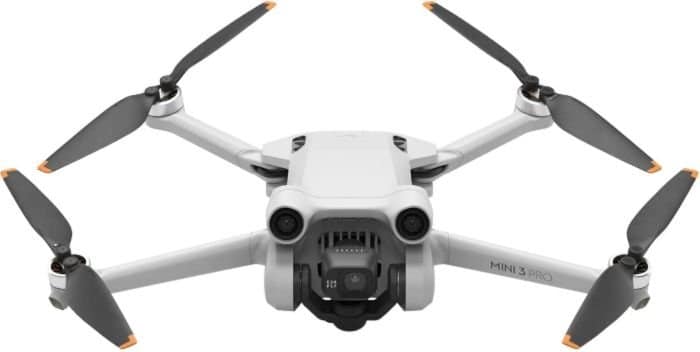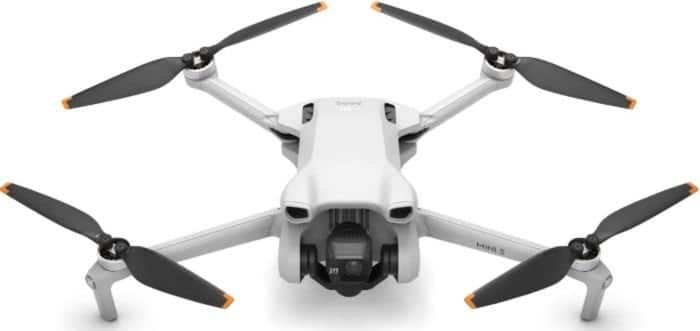The DJI Mini 3 and DJI Mini 3 Pro are two impressive drones that are very similar but also have some significant differences. In this comprehensive comparison of the DJI Mini 3 Pro vs Mini 3, we will compare their specifications, camera performance, flight capabilities, intelligent features, and safety aspects.
This will allow you to gain a robust understanding of these impressive drones and help you determine which one is the perfect match for your needs.
DJI Mini 3 Pro vs Mini 3 – Camera Performance
For many drone enthusiasts, the camera performance is a crucial factor. Let’s explore the camera capabilities of the DJI Mini 3 Pro vs Mini 3. Both drones have the same sensor size, but some differences exist.
DJI Mini 3 Pro
The DJI Mini 3 Pro features a camera with several impressive capabilities. It is equipped with a 1/1.3-inch CMOS sensor that supports dual native ISO and can output HDR footage directly.
This sensor provides a higher dynamic range, allowing for more details to be captured in both highlights and shadows.
The camera has big 2.4μm pixels and an aperture ratio of f/1.7, which means it can capture more light, resulting in true-to-life images even in low-light conditions. It supports aerial photography with stunning 4K HDR video and 48MP RAW photos, ensuring rich clarity and detail.
For video recording, it offers options for 4K at 60fps, 2.7K at 60fps and 1080p at 120fps for slow-motion video.
The DJI Mini 3 Pro also features a D-Cinelike colour mode, which offers richer colour possibilities for greater flexibility during post-production editing. This advanced colour profile preserves more information from the sensor, enabling users to get the most out of the drone’s camera for truly cinematic results.
Moreover, users have the option to record in the H.265 codec. This next-gen video compression standard significantly improves video quality and efficiency. It provides superior video quality and detail, even at the same bitrate as H.264, while its more efficient compression allows for smoother streaming and smaller file sizes. This makes it ideal for those looking to capture high-quality video footage without the need for excessive storage space.
Overall, the DJI Mini 3 Pro’s camera is designed to deliver exceptional image and video quality, allowing users to capture breathtaking footage and take their aerial photography to the next level.
DJI Mini 3
When it comes to camera capabilities, the DJI Mini 3 holds its ground, despite a few differences from the Mini 3 Pro. Like its advanced sibling, the Mini 3 can capture images in both 12MP and 48MP, delivering exceptional picture quality.
It also offers the ability to record striking 4K videos, making it a potent choice for your aerial cinematography needs.
However, it’s worth noting some distinctions that may impact your decision, depending on your specific requirements. One of these is the frame rate for 4K video recording; while the Mini 3 Pro offers an impressive 60fps, the Mini 3 tops out at 30fps.
In terms of video compression, the Mini 3 is a touch more limited. It supports the H.264 codec exclusively, while the Mini 3 Pro provides flexibility with both H.264 and the more efficient H.265 codecs.
This could be a deciding factor if you’re looking to streamline your workflow with smaller file sizes and richer video quality offered by the H.265 codec.
On the topic of bitrate, the Mini 3 offers a robust 100mbps, which is certainly adequate for high-quality footage. Nevertheless, the Mini 3 Pro takes it up a notch, providing an increased bitrate of 150mbps, which translates to even finer detail in your videos.
For those interested in Zoom capabilities, both drones offer similar features. You can expect a zoom range of 2x for 4K video, 3x for 2.7K video, and a solid 4x for Full HD video.
While the DJI Mini 3 and the DJI Mini 3 Pro share a lot of common ground, these subtle differences can significantly impact your videography experience, depending on what you’re after.
Flight Performance
Flight performance is a crucial aspect to consider when choosing a drone. Let’s compare the flight capabilities of the Mini 3 and Mini 3 Pro.
DJI Mini 3 Pro
The Mini 3 Pro comes with an impressive flight time of 34 minutes; this can be extended to 47 minutes with an intelligent plus battery. This makes it one of the best drones with the longest flight times.
The drone also has a top speed of 35mph which can only be achieved when flown in sports mode.
The Mini 3 Pro also has good performance in windy conditions with its Level 5 Wind Resistance rating.
What sets the Mini 3 Pro apart is its adoption of the new DJI O3 (OcuSync 3.0) transmission system. This system ensures high-quality video transmission directly to your smartphone or the RC Pro controller from a maximum range of 12 KM.
DJI Mini 3
Regarding capabilities, the Mini 3 has many features found in the Mini 3 Pro, but it excels with its flight time.
Operating on its standard battery, the Mini 3 has a flight time of 38 minutes, which is very impressive. However, when equipped with an Intelligent Plus Battery, it soars to an incredible 51 minutes.
This gives the Mini 3 the edge over the Mini 3 Pro. Indeed, at the time of writing this article, the Mini 3, when armed with an Intelligent Plus Battery, boasts the longest flight duration of any DJI consumer drone.
Turning our attention to transmission technology, the Mini 3 employs DJI’s OcuSync 2.0. This results in a solid video transmission range of 10km.
This doesn’t quite match up to the Mini 3 Pro’s 12km range. But here’s a key point: unless you’re cleared for Beyond Visual Line of Sight (BVLOS) operations, the transmission range shouldn’t necessarily be a deal-breaker.
Intelligent Features
While both the Mini 3 and the Mini 3 Pro are equipped with intelligent flight modes, it’s in this area that the Mini 3 Pro truly shines. The Mini 3, while no slouch, is missing some of these advanced features.
Both drones are armed with the Quickshot function, a user-friendly feature enabling the recording of high-definition videos with a simple click. These videos can then be seamlessly edited within the DJI Fly app, ready to be shared with your social media community.
Another shared trait is the GPS-assisted Return to Home function. This can be activated either automatically or manually via the remote controller or app, ensuring your drone always makes it back to you safely.
However, the Mini 3 Pro takes the lead with its exclusive suite of intelligent flight modes such as Active Track, Point of Interest, and Spotlight.
The Mini 3 Pro further expands its capabilities with the MasterShots function. An upgrade on the Quickshots feature, MasterShots elevates your aerial footage to new heights. Not to mention, the Mini 3 Pro also includes the Hyperlapse feature, enabling users to record striking time-lapse videos with ease.
So, while both drones boast an array of intelligent features, the Mini 3 Pro’s advanced capabilities cater to those seeking a more feature-rich flight experience.
Are The DJI Mini 3 Pro & DJI Mini 3 Suitable For Beginners?
Absolutely, both the DJI Mini 3 Pro and the Mini 3 are excellent options for beginners. They are designed to be user-friendly and accessible, making them ideal for those new to the world of drone piloting.
However, it’s essential to keep in mind that these drones come with a higher price tag. If you’re working with a limited budget, there are more affordable alternatives to consider. The DJI Mini 2, DJI Mini 2 SE, and Potensic Atom SE are among these options, providing excellent value for your money.
Despite their lower price point, these drones still boast impressive features. They come equipped with high-definition cameras, stabilized by 3-axis gimbals, and offer features like Quickshots. Moreover, they provide at least 30 minutes of flight time, which is an excellent duration for beginner drone enthusiasts.
Recap – Main Differences Between the DJI Mini 3 Pro and DJI Mini 3
To sum it all up, here’s a brief comparison between the DJI Mini 3 Pro and the DJI Mini 3:
Camera Capabilities – Both drones are equipped with the same sensor and can capture images at 12MP and 48MP resolutions and record 4K HDR videos. The Mini 3 Pro, however, provide superior options like a higher frame rate and bitrate for its 4K video recording. It also offers a choice between the H.264 and H.265 codecs, a D-Cinelike colour profile, and an expanded ISO range.
Flight Duration – This is one area where the DJI Mini 3 excels. It boasts one of the longest flight times of any consumer drone on the market, with a maximum duration of 38 minutes. The DJI Mini 3 Pro isn’t far behind, clocking in at 34 minutes of flight time. With the addition of an intelligent plus battery, these times can be stretched to 51 minutes and 47 minutes, respectively.
Video Transmission Range – Here, the DJI Mini 3 Pro has a longer range thanks to the latest OcuSync 3.0 technology, delivering a video transmission range of up to 12km. The Mini 3, using the slightly older OcuSync 2.0, offers a range of 10km.
Intelligent Flight Features – While both drones come equipped with Quickshots and GPS-assisted return-to-home functionality, there’s a slight difference in their offerings. The Mini 3 Pro features six Quickshots, while the Mini 3 comes with five. Adding to its repertoire of advanced features, the DJI Mini 3 Pro is equipped with Mastershots, Active Track 4.0, POI 3.0, Spotlight 2.0, and Hyperlapse for time-lapse videos. The Mini 3 shines in safety aspects with its 3-way obstacle avoidance system.
Do You Have To Register The DJI Miji 3 Pro or The DJI Mini 3?
In the United States, the Federal Aviation Administration (FAA) mandates the registration of all drones that weigh over 250 grams. Hence, drones that fall under the weight limit of 250 grams are exempted from the registration process when flown for recreational purposes.
That said, if you are a novice drone operator, it’s crucial to complete the FAA’s The Recreational UAS Safety Test (TRUST). This test has been specifically crafted for beginners, aiming to ensure that they comprehend the fundamental regulations associated with the recreational use of drones.
In the UK, if you are a first-time drone operator, you will need to obtain a Flyer ID and an Operator ID from the CAA.
Please be aware these rules can change and vary from one country to another, so it’s important to check the current regulations in your specific area before you start flying. Always make sure to follow local drone laws and safety guidelines to ensure safe and responsible flying.
Final Thoughts
In conclusion, both the DJI Mini 3 and Mini 3 Pro are impressive drones with their unique features. The Mini 3 is a budget-friendly option, perfect for beginners and those looking for an accessible flying experience. On the other hand, the Mini 3 Pro offers advanced camera capabilities, extended flight range, and intelligent features that cater to more experienced pilots and content creators.
Ultimately, the choice between the DJI Mini 3 and Mini 3 Pro depends on your specific needs, budget, and desired features. Evaluate the specifications, camera performance, flight capabilities, intelligent features, and safety aspects to determine which drone is the perfect fit for you. Happy flying!



